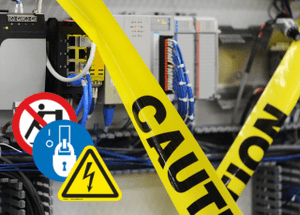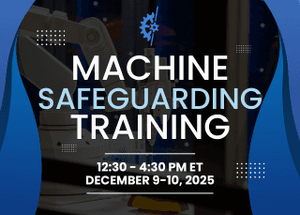Arc Flash Awareness and Electrical Workplace Safety

Year in and year out, workplaces seem to be running afoul of the same basic safety violations, which the Occupational Safety and Health Administration (OSHA) chronicles on an annual basis. Chief among them for a long time now has been electrical safety, be it in the general sense or specific, such as wiring methods.
To further solidify the ongoing need for arc flash safety awareness, in 2019, lockout/tagout was included on OSHA's list of top workplace safety violations, taking the 4th spot. A large number of employers cited for this violation failed to establish an energy control procedure altogether. Other companies received citations for a variety of offenses including failure to provide employees with proper training, not performing ongoing evaluations of procedures and failing to use appropriate lockout/tagout equipment. Plastics manufacturers, sawmills and machine/equipment shops were among the companies cited most for violations.
What are arc flashes? How do they come about? How do companies keep their teams protected and in compliance with safety protocols? Read on for these answers and more.
What Is an Arc
Flash?
As defined by Electrical Safety Foundation International (ESFI), arc flashes
come about when there's a breakdown between two or more conductors resulting in
the sudden release of built-up energy. In a controlled environment, arcs are
normal. In fact, you see the product of arcs virtually every day, as the
electrodes inside light bulbs form arcs in order to illuminate.
But when a gap exists, the pent-up energy has to go somewhere, typically resulting in an explosion that is extremely hot, capable of causing second-degree burns or even death. In fact, arc flash temperatures can be four times hotter than that of the sun — reaching 35,000 degrees Fahrenheit.
The State of Arc Flash Safety
Although more protections are in place to guard against electrical-related
injuries, they remain a common problem for workplaces. Consider these sobering
statistics from the ESFI:
- 360 electrical injuries were reported in the construction industry between 2003-2017.
- There was a 35% increase in electrical injuries between 2016 and 2017.
- People miss a median total of approximately ten days from work due to electrical injuries.
- 5% of electrical injuries in 2017 were fatal.
- 54% of electrical fatalities, such as electrocutions, affected businesses in construction from 2003 to 2017.
- During the same timeframe, contact with/exposure to electricity was the 6 th most common cause of workplace fatalities.
- Younger workers are more than two times more likely to be killed by electrical accidents compared to more seasoned employees.
The intense heat arc flashes give off makes just about anything that's within the vicinity of them potentially flammable, including clothing, equipment and furniture. Because of this, hazard mitigation strategies must be implemented and communicating electrical safety hazards is crucial.
Arc Flash History
One of the most basic and effective methods to implement derives from safety
warning and labels. For many years, there weren't any specific requirements
that employers had to comply with. However, the National Fire Protection
Association (NFPA) updated the
National Electrical Code in 2000. One of the provisions required employers to
inform workers, such as maintenance people, about the potential for arc flashes
when working on electrical grids, fuse boxes and panels through signage. The
mandate also necessitated that maintenance workers wear personal protective
equipment, or PPE, such as fire resistant gloves, clothing and face shields.
Ever since then, OSHA and the NFPA have worked in consultation with one another to better protect individuals working with electrical equipment from arc flashes. For instance, in 2014, OSHA published new requirements in the Federal Register that mandated employers to arrange for safety assessments so they can determine the probability of arc flashes occurring in electrically charged environments.
Standardization of a New ISO Symbol for Arc
Flash
In 2016, arc flash warnings received an important update. Up until that time,
there wasn’t a single, standardized symbol to warn of arc flash hazards. A new
symbol, approved through the International Organization for Standardization
(ISO) was created specifically for this hazard.
Angela Lambert, director of standards compliance at Clarion Safety, notes that the update helps provide more clarity about what dangers exist, specifically as they relate to arc flashes.
"The new arc flash symbol better communicates the hazard at hand than the symbol for electricity or other similar symbols," Lambert explained. "It provides a clear distinction for arc flash hazards."
Strategies for Arc Flash Prevention
Here are a few strategies you can
implement that can keep your workers and customers protected:
- Arc Flash Safety
Assessment
Arc flash incidents often have several characteristics in common in order for them to happen. Having a safety assessment can help you identify what these are so you can implement the proper protocols, such as labeling and providing PPE. - Invest in
Protective Equipment
Electricians and businesses that sell or provide electrical services may need to ensure that their workers have flame-resistant clothing, gloves and eye protection. You can never go wrong by investing in safety gear. Flame-resistant face guards, boots and other arc-rated clothing are highly recommended. - Considerations for Arc Flash PPE During
COVID-19
As the impact of an arc flash can ultimately be fatal, PPE in the electrical industry is considered the last line of defense if an arc flash occurs. Though some arc flash PPE equipment can be laundered at home using standard washing machines, certain equipment and gear require different cleansing methods to maintain their protective integrity. To support the health and safety of electrical workers, here is a compiled list of suggestions to properly disinfect the components of an arc flash kit:- Arc suit: Suiting can be washed in standard washing machines. It is advised to follow the care instructions provided by the manufacturer.
- Leather gloves: As leather can tear, crack and peel, hand wash gloves in mild soap and water for twenty seconds and allow them to air dry.
- Face shields: Shields can be disinfected using mild soap and water. If proper disinfecting is impossible, using 70% isopropyl alcohol or alcohol wipes to clean face shields is recommended, though it is critical to ensure that the shield is completely dry before reusing, as alcohol is flammable.
- Voltage-rated rubber gloves: Hand wash with soap and water and let air dry.
It is also strongly advised that electrical workers do not share their PPE as the disinfecting process is difficult to successfully undergo when working in the field. Though some manufacturers have altered disinfecting procedures for equipment while in the field due to COVID-19, using strong disinfectants such as bleach or other harsh chemical cleansers is not recommended. They can jeopardize the effectiveness of the clothing, suiting and other critical arc flash equipment and gear, leaving workers susceptible to flash or electrocution hazards.
Leading Safety
Visuals to Communicate Arc Flash Hazards
Warning people of arc flash hazards is
critical to their health and safety. Clarion Safety has long been involved at
the leadership level in
best practice arc flash label design, and our arc flash labels are
compliant with ISO 7010, as well as ANSI Z535, NFPA 70E and NEC. Whether you
need help in identifying potential arc flash hazards through a risk assessment
or you need state-of-the-art warnings, we’re here to help.
Get in touch with us and let
us know how we can help improve your arc flash safety program.



